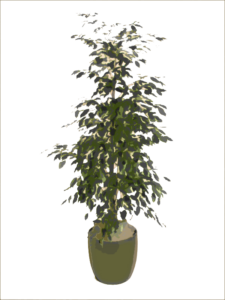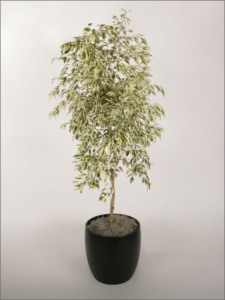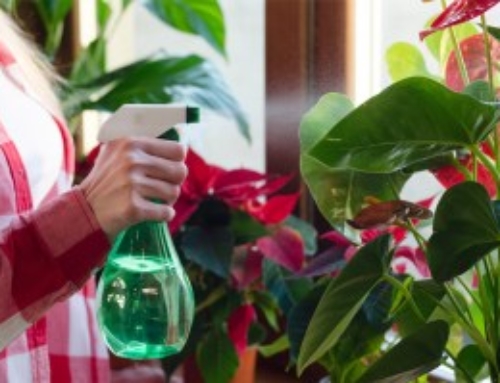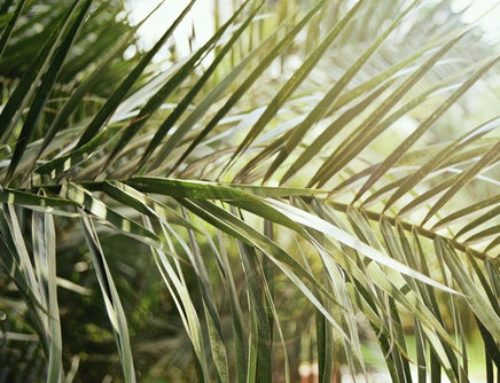 Ficus benjamina (weeping fig), part of the large Moraceae, or Mulberry, family, are native to Southeast Asia, India and Australia. F. benjamina has glossy green elliptical shaped leaves and a light tan colored trunk. Mature plants may produce small, inedible figs. Ficus benjaminas are available in a wide variety of forms including multiple standards, braided, single trunks, bonsai, bush and corkscrew.
Ficus benjamina (weeping fig), part of the large Moraceae, or Mulberry, family, are native to Southeast Asia, India and Australia. F. benjamina has glossy green elliptical shaped leaves and a light tan colored trunk. Mature plants may produce small, inedible figs. Ficus benjaminas are available in a wide variety of forms including multiple standards, braided, single trunks, bonsai, bush and corkscrew.
Adjusting to the indoor environment
Ficus benjaminas grown in high light use vast amounts of water, grow rapidly and produce thick foliage canopies. Leaves are light colored, cup-shaped, thicker and smaller in size than leaves grown under low light. These adaptations protect leaf surfaces from high light intensity, reduce transpiration rates and help conserve moisture.
Ficus varieties used in interiorscapes need to adjust to lower humidity levels and light intensities. To begin the acclimatization process, Ficus grown in direct sun are moved to shade houses for 8 to 10 weeks before they are shipped to interiorscapers. As the Ficus adjusts to the lower light levels, it drops leaves it can no longer support. Growers reduce water and fertilizer levels to help slow the plant’s rapid metabolism and conserve food reserves. The plant acclimates further when placed in the interiorscape. The entire adjustment period may take up to three months. A fully acclimated Ficus produces leaves that are deep green, thinner, more supple and larger than sun-grown leaves. The foliage canopy is more open and spreading. Growth is slower and the Ficus requires less water. To help new Ficus adjust to the indoor environment, remove excess fertilizers from the top of grow pots. Closely monitor the moisture in the media. A new Ficus uses more water initially arid less water as it acclimates. To allow more light to reach individual leaves, thin dense clumps of foliage; remove yellow leaves; prune twigs and branches growing towards the center.
Keeping roots healthy
 Ficus roots need a growing media with a pH between 5.5 and 6.5, and good pore space for gas exchanges and root expansion. Keep roots healthy by watering the entire root ball thoroughly, then allowing the plant to dry out sufficiently. In medium light (100 – 200fc) allow growing media to dry down 1/3 of the container; in higher light conditions allow media to dry down 2″ to 1/4 of the pot.
Ficus roots need a growing media with a pH between 5.5 and 6.5, and good pore space for gas exchanges and root expansion. Keep roots healthy by watering the entire root ball thoroughly, then allowing the plant to dry out sufficiently. In medium light (100 – 200fc) allow growing media to dry down 1/3 of the container; in higher light conditions allow media to dry down 2″ to 1/4 of the pot.
Roots can be damaged by improper moisture levels. Underwatered plants develop symptoms such as mottled yellow leaves, leaf drop and withered stems. Overwatered plants drop green leaves, show signs of stunted and pale new growth, and may develop root and stem rots.
Fertilize healthy plants with a complete water-soluble fertilizer during times of active growth. Do not fertilize unacclimated, stressed or infested plants. Test the growing media periodically for excess soluble salts which can damage delicate roots and interfere with water absorption. Ficus benjamina has dense, fibrous root systems that grow rapidly. Ficus grown in medium light conditions prefer to be slightly root boxed, but plants in high light may need to be root pruned and repotted every 2-3 years.
Keeping foliage healthy
Ficus benjamina prefer a minimum light range of 200fc, but can be acclimated to light levels around 100FC. Plants in higher light grow faster and use more water than similar plants in lower light. Ficus benjamina are very phototropic and need to be rotated regularly.
Clean Ficus leaves regularly to promote healthy growth. Commercial solutions such as Leaf-Tek by Leaf-Tek Products or Clean & Feed by Botanical Science work well at cleaning built up grime and dust on foliage. If you prefer, you can mix up a mild solution of 1-2 tsp dish soap and 2 tbsp alcohol mixed in 1-quart water. Spray until runoff and hand wipe foliage with sponges or rags. Gently wipe branches and trunk with a soap solution and a sponge to remove dust, insect pests and sap.
Ficus are pruned for varying reasons — to help acclimate the plant, to remove pests or to thin and shape the tree as it ages. Follow these guidelines when priming Ficus benjaminas:
- Use sharp primers and scissors to prevent damaging bark tissue.
- Cut close to, but not into, the bark branch collar (the slight swelling located where one branch connects to another branch or trunk)
- Do not remove more than 30% of the foliage at one time.
Ficus are susceptible to scale, mealy bug, spider mites, excess soluble salts, Phomopsis die back, and air pollution. Control pests by pruning out small infestations, wiping individual pests with alcohol on a cotton swab or washing off pests with dish soap and water. Control disease development by providing the correct environmental conditions and moisture levels for optimum growth. Monitor soluble salt levels and leach media regularly to prevent salt build up.





